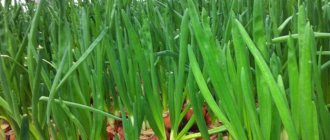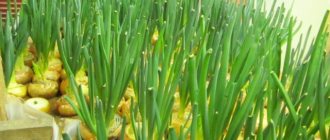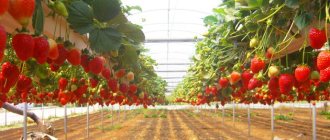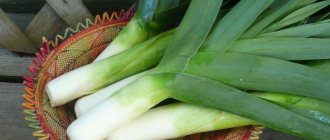Growing and selling green onions is risky and labor-intensive. But I tried it anyway.
The idea to start this particular production came to me after carefully studying forums with ambitious young entrepreneurs.
Young hot minds generate business plans at the speed of light - both crazy, and banal, and completely hackneyed. But you can also find fresh ideas there that you haven’t even thought about before. So the thought of onions stuck in my head.
Having calculated the initial investment and my capabilities, I made a decision - it’s time to grow greens!
Maxim L. told the story of his earnings.
Is it profitable and what are the features of the onion business?
Every housewife knows that onions can be grown at home on the windowsill in a jar of water .
For a large-scale business that must generate significant income, such a growing system will not be suitable. In the summer, onions are actively grown in beds in fertile soil, and in winter they are transferred to a greenhouse with heating and maintained humidity.
If you have your own summer cottage, you only need to purchase planting material and fertilizers , as well as stock up on an irrigation system.
However, you can grow only a few onions this way, and the constant competition from other summer residents, who can also adopt this idea, is not at all encouraging. In this case, there is a lot of goods on the market, and they spoil quickly, and there is little income, since the price of onions on the market is underestimated due to an oversupply of onions on the market.
The situation changes dramatically in winter and off-season, when demand is high and suppliers are few. The price of onions noticeably increases by 2-3 times, and there is less competition. With this type of business, income covers all expenses. In addition, growing onions in a greenhouse is 45% faster , which allows you to harvest every 35 days.
Important! It is more profitable and profitable to run an onion growing business in winter and in the off-season.
Which form of business to choose?
Let's analyze the different forms of doing business in the table below.
| Form of business organization | Benefits of use |
| Private household plot (private household plot) | This form is used only by individuals to sell products to large distributors. Possibility of organization if you have a plot of up to 2 hectares, simple requirements: you only need to obtain a certificate from the local administration that this plot belongs to you and is used for growing onions. |
| IP (individual entrepreneur) | This form is used for self-selling products. Individual entrepreneur status gives the manufacturer legal force and allows him to organize the implementation himself. Possibility to create a sales network. The process of product certification is becoming more complicated. |
| LLC (limited liability company) | This form is used for additional business financing through agricultural loans and when hiring employees. Suitable for working with shops and wholesale centers. |
| Peasant farm (peasant farm) | This form is used to attract partners to your business. Peasant farms simplified by the form of LLP (limited liability partnership), as well as individual entrepreneurs and LLCs, are endowed with legal force. It is possible to work with stores and wholesale suppliers. |
Initially, you can register as a private household plot and start selling in small quantities to set up all production processes and sales channels. Private household plots do not pay taxes on any volume of production. To scale production and increase sales, you must register as an individual entrepreneur.
For an individual entrepreneur, the optimal choice of taxation system for producers of agricultural products is the Unified Agricultural Tax (USAT).
Tax rate – 6%
Video lesson “Unified Agricultural Tax”
Advantages and disadvantages
Onions are a source of phytoncides, enzymes and essential vitamins for the body. 100 g of vegetable contains the daily requirement :
- vitamin C, A, B1 and B2;
- phosphorus;
- folic acid.
Onions are actively purchased by people at any time of the year, which makes them a profitable product for production.
The advantages of running such a business:
- Minimum investment and high profitability (over 45%), in winter over 150%.
- A business is quick to open and easy to register.
- The production process does not require complex equipment or serious physical effort.
- There are special varieties of green onions that can be grown all year round.
- Huge sales opportunities and constant demand.
Minuses:
- A large number of competitors in the summer.
- A perishable product, the need to find sales lines and regular buyers.
- For beginners, a commercial greenhouse system can be an expensive purchase.
How to write a business plan and what is needed?
Before starting a business, it is necessary to draw up a business plan with a development strategy, calculation of costs and profitability of the enterprise.
Features that you need to pay attention to when drawing up a business plan for growing onions:
- Identifying the intricacies of organizing onion cultivation in summer and winter.
- Selection of onion varieties.
- Choice of growing technology: open ground, hydroponics, greenhouses.
- Market demand analysis.
- Registration of business with accounting authorities.
- Financial calculations: investments, calculation of possible profits and expenses.
Important! With a well-written business plan, it is much easier to run a business, since a strategy has been outlined and all costs and return on investment have been calculated.
Varieties for forcing greens to harvest in winter
In winter, the entrepreneur will have to maintain and maintain expensive greenhouses, so it is important to choose varieties of green onions that can quickly produce a harvest.
Onions planted in closed ground in autumn or winter will not produce a harvest , since there are still buds of shoots in them.
It is necessary to use other varieties that will provide an uninterrupted harvest.
Onion
In appearance and taste, this variety is no different from its ordinary onion relative. The species does not form a bulb, so it must be planted from seeds. Greens grow at a temperature of 15 degrees and a humidity of 85%. Productivity – 4 kg/sq.m.
You can familiarize yourself with the features of planting and growing this crop here:
Leek
The variety resembles the feathers of garlic and grows from a thick white stem that is also eaten. Seeds are planted in pre-dug grooves 12 cm deep. Productivity – 2 kg/sq.m.
A complete description of the leek cultivation technique and important growing tips can be found in this video:
shallot
Dense branching of feathers distinguishes shallots from onions, but otherwise they are similar. Feathers reach a length of up to 35 cm and mature 30 days after planting . Productivity – 4 kg/sq.m.
Shallots - agricultural technology, full cycle from planting to storage:
Schnitt
This variety is picky about lighting; if it is insufficient, the shoots grow pale and devoid of taste. Productivity – 3.5 kg/sq.m.
Slime
The feathers of the vegetable have a garlicky aroma and are filled with mucus inside. This variety constantly produces new shoots, which is distinguished by its huge yield - 4.5 kg/sq.m.
Multi-tiered
Feathers reach a length of up to 45-50 cm; this variety is also called Egyptian . Productivity – 4 kg/sq.m.
You will find the description and features of this onion variety below:
Methods for increasing green onion yield
To increase the yield of onion feathers, you can use the following approaches:
- Loosening the soil allows oxygen to be delivered to the onion horse system. Do not allow the formation of a hard crust on the soil surface! 2-3 days after watering, it is necessary to loosen the soil.
- Watering onions - water is one of the main nutrient media for feather growth, so you should water it 2 times a week! If the climate is extremely hot and dry, the frequency of watering can reach 3 times a week. Also, the younger the onion, the more moisture it requires.
- Fertilizing onions - when watering, nitroammophoska solutions are added to the water to enhance feather growth. It is recommended to use fertilizer after the first cut to stimulate further feather growth.
- Weed removal – Keep the soil clear of weeds and other crops. If dill is planted between the beds when growing onions, this is not done when growing onions.
- Covering the bed for the winter - in winter, the onions are covered with 3-3.5 cm of humus or straw and peat.
Methods: how to grow green feathers to make money?
To grow onions on an industrial scale, it is important to ensure access of moisture and fertilizers to the roots of the greenery. We list the main methods of planting onions:
- Into the ground . The soil should be filled with organic matter - peat and sand. Seeds or seedlings are planted in open ground in early spring to get a harvest in the summer. In greenhouse conditions, planting can be done at any time.
- On sawdust .
Wood shavings are a loose base for planting onions, and they allow water to pass through well. Sawdust does not contain organic matter or nutrients; it is necessary to regularly supply the crops with a solution of organic fertilizers or sprinkle them with wood ash and saltpeter. The advantages of this method are its cleanliness, since sawdust does not contaminate the feathers, which makes harvesting easier. After harvesting the onions, you can add a new 3 cm layer of sawdust, water it and plant the seeds again. - Hydroponics . This method involves special mats filled with a nutrient solution. The basis of the canvas is coconut shavings, which perfectly retains onion rhizomes and is hygroscopic. For the first 10-11 days you will have to keep the crops in complete darkness; as soon as they germinate, you can move on to the usual daylight hours.
- Aeroponics . This method excludes any type of substrate, which allows you to keep the feathers clean and prevents the risk of developing green diseases (discussions about diseases and pests of green plants are described here). The seeds are placed in containers so that the rhizomes are exposed to air. The roots are constantly irrigated with aerosolized nutrients by spraying. The method gives maximum yield.
Which growing technology works best?
Greenhouse production of onions is based on several technologies. All of them are simple, save energy and time, and do not require the use of agricultural technology.
Actively used methods of year-round cultivation of this plant:
- growing on sawdust;
- hydroponics;
- using shelving to increase usable space.
Using them, you will end up with onions grown at home without a greenhouse, in a warm barn, garage, basement or other utility room.
Onions in sawdust
The porous structure of sawdust absorbs moisture well and also releases it well. It is loose and provides the rhizomes with the necessary amount of oxygen. These are the main advantages of the method. Before using sawdust, they are doused with boiling water to disinfect them.
The bulbs are soaked in a solution of potassium permanganate. Sawdust is poured into flat, shallow containers, and the bulbs are laid out on them. Water the prepared “bed” with warm water. To germinate onions faster, cover the rack with film.
Hydroponics method
The method is based on a system of planting plants without soil in water enriched with nutrients. To grow, you need a hydroponic setup. The costs of its acquisition are more than offset by a stable harvest and ease of maintenance.
Agronomists consider hydroponic cultivation of dill, strawberries, and vegetables to be the most convenient and effective method of year-round cultivation.
Growing on multi-tiered racks
Multi-tiered shelving structures save space and increase harvest volumes. They provide good heating of crops in winter. Shelves make it convenient to water plants, making it easier to harvest and plant new crops.
To make shelving, use wooden boards or metal fittings and corners. Installation of structures is carried out during the installation of the greenhouse. The structures can also be installed in an already equipped room.
With this growing method, possible nuances should be taken into account: uneven lighting, different soil temperatures and lack of drainage
Sales organization
The hope for a quick sale of goods is always present for a beginning farmer, however, it is actually somewhat different, for several reasons:
- in the off-season and winter, inflated prices scare away buyers, and the goods quickly deteriorate;
- Buy no more than 3 bunches of greens at a time.
It will not be possible to sell a ton of onions at once and immediately receive income , so in a business plan it is important to immediately think through sales lines and find regular buyers. Some options for selling products:
- Sales to wholesalers. In almost every region there are wholesalers to whom you can sell your harvest.
- Searching for buyers through online advertisements.
- Offering goods to catering establishments and cafes. Here you will have to use the gift of persuasion and be able to adequately present your product.
- Sales through grocery stores and supermarkets.
- Independent sale.
Important! If you sell it yourself, there may be large costs for hiring salespeople, renting a retail outlet, and transporting the goods.
Nuances
Once it happened that Tamara did not buy the next batch of onions. I had to resort to the option of small cafes and restaurants, but even so it was not possible to sell the entire batch, which affected the overall profit.
There is also a possibility of disease occurring in the seedlings, in which case it is necessary to act quickly and look for fertilizers with medicines, and this is an unforeseen expense.
The planting material itself may also be a problem. It may happen that even a good seed will not give the desired harvest, simply because it was grown before you in poor conditions.
We won’t know about it when we buy it, but we will understand everything when there is no turning back. In dealing with natural products, there is always room for accidents, deception and dishonest partners, even if all the pitfalls have been taken into account.
Do you have a vegetable garden? Do you sell homegrown produce? Ever thought about larger scale production?
Revenues and profitability
Experienced farmers claim that the first cut of onion feathers is 75% more than the original weight of the planted bulb . If we take as an example a tray that holds 6 kg of planting material, then the yield from it will be about 3.6 kg, that is, 7.2 kg per season.
| Pok-l | Winter | spring | Summer | autumn |
| Yield per tray, kg | 7,2 | 7,2 | 7,2 | 7,2 |
| Profit from the tray, rub | 230 | 130 | 35 | 130 |
| About. Profit, rub | 1656 | 936 | 252 | 936 |
The table shows that growing onions is a profitable business; on average, experienced gardeners can earn about 2 million rubles in a year.
Read our materials about the nuances of crop rotation, fertilizing, watering, collecting onions, and also about planting in snails.
Expenses
To engage in such a business, investments in the region of 1 million rubles will be required. This is due to the costs of greenhouses, although you can save money by choosing to rent a room.
I used my own area where I placed the greenhouses. Capital went to:
- 2 turnkey greenhouses - 540 thousand rubles.
- Heat supply system – 50 thousand rubles.
- Planting material – 175 thousand rubles.
- Delivery – 25 thousand rubles.
- Sand and black soil for shelving – 20 thousand rubles.
- Racks – 80 thousand rubles.
- Cutting knives, auxiliary tools, hoses for wells - 10 thousand rubles.
- Planting the first batch in 10 days with 3 people working (500 rubles/person) – 15 thousand rubles.
Monthly expenses were:
- Salary to employees – 45 thousand rubles.
- Electricity - 10 thousand rubles.
- Renting a gazelle for transportation – 7.5 thousand rubles.
The cost of one kilogram of onions with my expenses was 86 rubles/kg.
- The price of sets is 22 rubles/kg.
- Growing costs (worker wages, electricity, logistics) – 64 rubles/kg.
From this it turns out that even with a price of 100 rubles/kg, I would make a profit.
As a result, it turns out that with all the initial investments and monthly expenses, I spent 1.04 million rubles in three months. The profit amounted to 647,400 rubles.
If I continued this business, then in another three months (skipping the summer) I would have recouped the starting investment and started making good money.
However, after one season, it was decided that I would invest the money I earned in another type of activity. The reason for this is very simple: green onions are not my thing.
The experience was interesting, but I didn’t want to continue. Greenhouses with shelving were sold for 580 thousand rubles, so in the end I still ended up with a profit.
How much can you harvest: onion yield from 1 hectare, 1 hundred square meters
The average yield of onions for greens and turnips per 1 hectare is 170-270 centners.
Beginning entrepreneurs should not immediately invest hundreds of thousands in greenhouse installations and developing an onion growing business. First, you should try your hand at a small greenhouse and garden plot , after developing your business and establishing sales routes, you can expand further. It will take about three seasons to understand the essence of the matter and develop regular customers.
This method of earning money is a promising and easily accessible type of activity.
Calculation of financial profit
In order to start your own business, you will need start-up investments, the amount of which depends on whether the entrepreneur has his own plot or premises where the greenhouse will be equipped. If you have such assets, twenty-five thousand rubles will be enough to implement the project. Let's look at how this money will be spent:
- Purchase and installation of lighting fixtures – seven thousand rubles.
- Racks with beds - six thousand rubles.
- Planting material – six thousand rubles.
- Boxes for planting greenery - a thousand rubles.
- Payment of utilities – five thousand rubles.
In one cycle, about sixty kilograms of greenery can be grown on an area of twenty square meters. Within one year, this greenhouse will be able to produce about two hundred and fifty kilograms of greenery. The average profit for this period will be about one hundred thousand rubles. From this amount it is necessary to deduct the capital invested and related expenses.
Agriculture is one of the most promising areas for doing business
Useful tips for businessmen
Such a result can only be achieved with an established market for finished products. One of the main tasks of an entrepreneur working in this field is to find regular customers . In order to find wholesale customers, you should place advertisements on specialized websites or in print publications. You should also try to visit various retail outlets on your own and negotiate with their owners.
The overall profitability of a business depends on the competence of solving organizational issues. Entrepreneurs working in this field can create their own brand by producing colorful packaging for their products. Such products are in great demand in large retail outlets.











